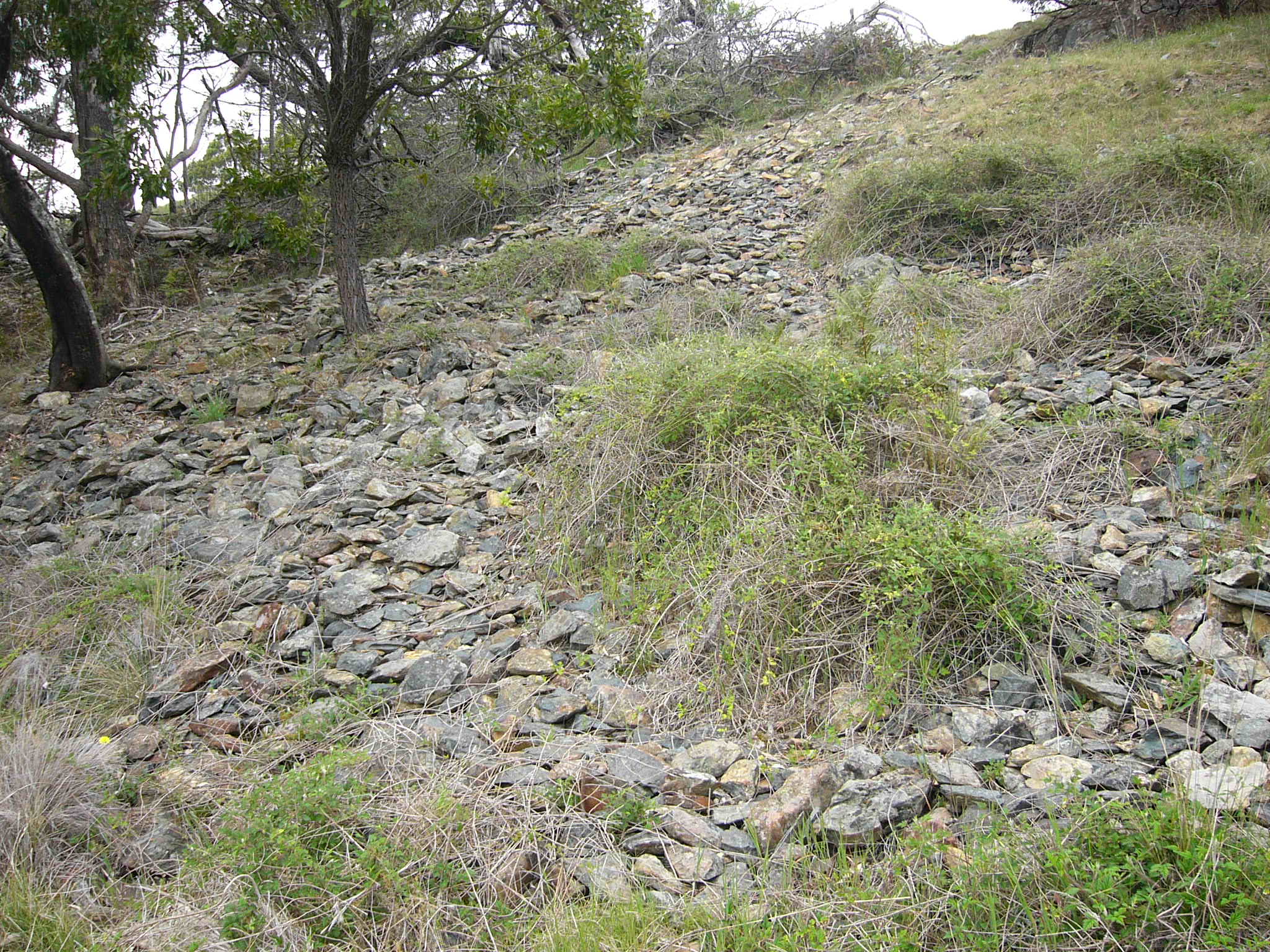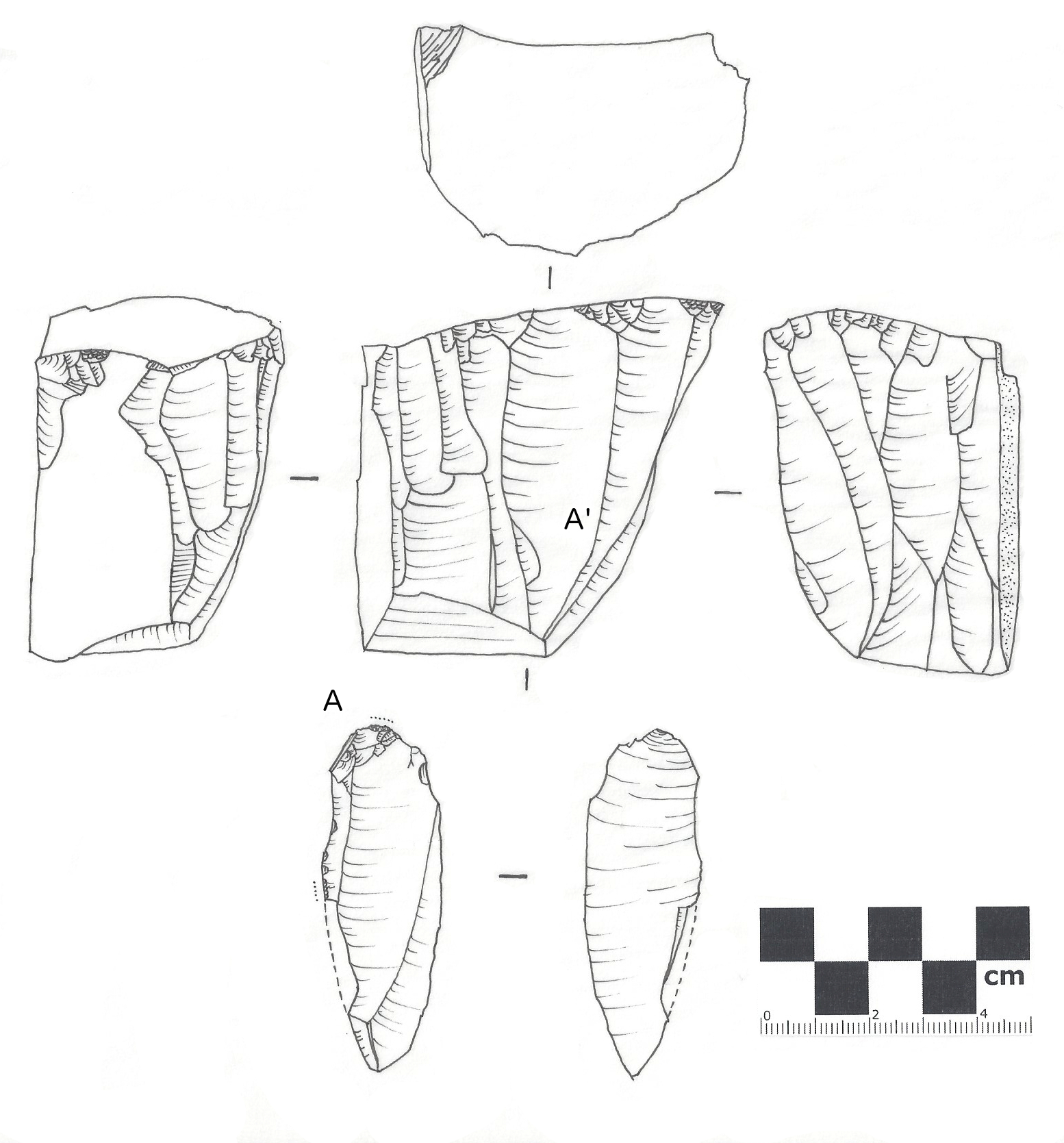|
Hammerstone
In archaeology, a hammerstone is a hard cobble used to strike off lithic flakes from a lump of tool stone during the process of lithic reduction. The hammerstone is a rather universal stone tool which appeared early in most regions of the world including Europe, India and North America. This technology was of major importance to prehistoric cultures before the development of metalworking. Materials A hammerstone is made of a material such as sandstone, limestone or quartzite, is often ovoid in shape (to fit the human hand better), and develops telltale battering marks on one or both ends. In archaeological recovery, hammerstones are often found in association with other stone tool artifacts, debitage and/or objects of the hammer such as ore. The modern use of hammerstones is now mostly limited to flintknappers and others who wish to develop a better understanding of how stone tools were made. Usage Hammerstones are or were used to produce flakes and hand axes as well a ... [...More Info...] [...Related Items...] OR: [Wikipedia] [Google] [Baidu] [Amazon] |
Stone Tool
Stone tools have been used throughout human history but are most closely associated with prehistoric cultures and in particular those of the Stone Age. Stone tools may be made of either ground stone or knapped stone, the latter fashioned by a craftsman called a flintknapper. Stone has been used to make a wide variety of tools throughout history, including arrowheads, spearheads, hand axes, and querns. Knapped stone tools are nearly ubiquitous in pre-metal-using societies because they are easily manufactured, the tool stone raw material is usually plentiful, and they are easy to transport and sharpen. The study of stone tools is a cornerstone of prehistoric archaeology because they are essentially indestructible and therefore a ubiquitous component of the archaeological record. Ethnoarchaeology is used to further the understanding and cultural implications of stone tool use and manufacture. Knapped stone tools are made from cryptocrystalline materials such as chert, f ... [...More Info...] [...Related Items...] OR: [Wikipedia] [Google] [Baidu] [Amazon] |
Hand Axe
A hand axe (or handaxe or Acheulean hand axe) is a Prehistory, prehistoric stone tool with two faces that is the longest-used tool in human history. It is made from stone, usually flint or chert that has been "reduced" and shaped from a larger piece by knapping, or hitting against another stone. They are characteristic of the lower Acheulean and middle Palaeolithic (Mousterian) periods, roughly 1.6 million years ago to about 100,000 years ago, and used by ''Homo erectus'' and other early humans, but rarely by ''Homo sapiens''. Their technical name (biface) comes from the fact that the archetypical model is a generally bifacial (with two wide sides or faces) and almond-shaped (amygdaloidal) lithic flake. Hand axes tend to be Symmetry, symmetrical along their longitudinal Symmetry axis, axis and formed by pressure or percussion. The most common hand axes have a pointed end and rounded base, which gives them their characteristic almond shape, and both faces have been Knapping, knap ... [...More Info...] [...Related Items...] OR: [Wikipedia] [Google] [Baidu] [Amazon] |
Lithic Reduction
In archaeology, in particular of the Stone Age, lithic reduction is the process of fashioning stones or rocks from their natural state into tools or weapons by removing some parts. It has been intensely studied and many archaeological industries are identified almost entirely by the lithic analysis of the precise style of their tools and the chaîne opératoire of the reduction techniques they used. Normally the starting point is the selection of a piece of tool stone that has been detached by natural geological processes, and is an appropriate size and shape. In some cases solid rock or larger boulders may be quarried and broken into suitable smaller pieces, and in others the starting point may be a piece of the debitage, a flake removed from a previous operation to make a larger tool. The selected piece is called the lithic core (also known as the "objective piece"). A basic distinction is that between flaked or knapped stone, the main subject here, and ground stone ... [...More Info...] [...Related Items...] OR: [Wikipedia] [Google] [Baidu] [Amazon] |
Lithic Flake
In archaeology, a lithic flake is a "portion of rock (geology), rock removed from an objective piece by percussion or pressure,"Andrefsky, W. (2005) ''Lithics: Macroscopic Approaches to Analysis''. 2d Ed. Cambridge, Cambridge University Press and may also be referred to as simply a ''flake'', or collectively as debitage. The objective piece, or the rock being reduced by the removal of flakes, is known as a lithic core, core.Andrefsky, W. (2005) ''Lithics: Macroscopic Approaches to Analysis''. 2d Ed. Cambridge, Cambridge University Press Once the proper tool stone has been selected, a percussor or pressure flaker (e.g., an antler Tine (structural), tine) is used to direct a sharp blow, or apply sufficient force, respectively, to the surface of the stone, often on the edge of the piece. The energy of this blow propagates through the material, often (termination type, but not always) producing a Hertzian cone of force which causes the rock to fracture in a controllable fashion. Since c ... [...More Info...] [...Related Items...] OR: [Wikipedia] [Google] [Baidu] [Amazon] |
Flint
Flint, occasionally flintstone, is a sedimentary cryptocrystalline form of the mineral quartz, categorized as the variety of chert that occurs in chalk or marly limestone. Historically, flint was widely used to make stone tools and start fires. Flint occurs chiefly as nodules and masses in sedimentary rocks, such as chalks and limestones.''The Flints from Portsdown Hill'' Inside the nodule, flint is usually dark grey or black, green, white, or brown in colour, and has a glassy or waxy appearance. A thin, oxidised layer on the outside of the nodules is usually different in colour, typically white and rough in texture. The nodules can often be found along s and [...More Info...] [...Related Items...] OR: [Wikipedia] [Google] [Baidu] [Amazon] |
Chalcolithic
The Chalcolithic ( ) (also called the Copper Age and Eneolithic) was an archaeological period characterized by the increasing use of smelted copper. It followed the Neolithic and preceded the Bronze Age. It occurred at different periods in different areas, but was absent in some parts of the world, such as Russia, where there was no well-defined Copper Age between the Stone and Bronze Ages. Stone tools were still predominantly used during this period. The Chalcolithic covers both the early cold working (hammering) of near pure copper ores, as exhibited by the likes of North American Great Lakes Old Copper complex, from around 6,500 BC, through the later copper smelting cultures. The archaeological site of Belovode, on Rudnik mountain in Serbia, has the world's oldest securely dated evidence of copper smelting at high temperature, from . The transition from Copper Age to Bronze Age in Europe occurred between the late 5th and the late In the Ancient Near East the Copper ... [...More Info...] [...Related Items...] OR: [Wikipedia] [Google] [Baidu] [Amazon] |
Malachite
Malachite () is a copper Carbonate mineral, carbonate hydroxide mineral, with the chemical formula, formula Basic copper carbonate, Cu2CO3(OH)2. This opaque, green-banded mineral crystallizes in the monoclinic crystal system, and most often forms botryoidal, fibrous, or stalagmite, stalagmitic masses, in fractures and deep, underground spaces, where the water table and hydrothermal fluids provide the means for chemical precipitation. Individual crystals are rare, but occur as slender to Acicular (crystal habit), acicular prisms. Pseudomorphs after more tabular or blocky azurite crystals also occur. Etymology and history The stone's name derives (via , , and Middle English ''melochites'') from Greek language, Greek Μολοχίτης λίθος ''molochites lithos'', "mallow-green stone", from μολόχη ''molochē'', variant of μαλάχη ''malāchē'', "mallow". The mineral was given this name due to its resemblance to the leaves of the Malva, mallow plant. Copper (Cu2+) g ... [...More Info...] [...Related Items...] OR: [Wikipedia] [Google] [Baidu] [Amazon] |
Langdale Axe Industry
The Langdale axe industry (or factory) is the name given by archaeologists to a Neolithic centre of specialised stone tool production in the Great Langdale area of the English Lake District. (For accompanying material seSupplement 1of same volume). The existence of the site, which dates from around 4,000–3,500 BC, was suggested by chance discoveries in the 1930s. More systematic investigations were undertaken by Clare Fell and others in the 1940s and 1950s, since when several field surveys of varying scope have been carried out. Typical finds include reject axes, rough-outs and blades created by knapping large lumps of the rock found in the scree or perhaps by simple quarrying or opencast mining. Hammerstones have also been found in the scree and other Stone tool, lithic debitage from the industry such as blades and Lithic flake, flakes. The area has outcrops of fine-grained greenstone (archaeology), greenstone or hornstone suitable for making polished stone axes. Such ... [...More Info...] [...Related Items...] OR: [Wikipedia] [Google] [Baidu] [Amazon] |
Neolithic Period
The Neolithic or New Stone Age (from Greek 'new' and 'stone') is an archaeological period, the final division of the Stone Age in Mesopotamia, Asia, Europe and Africa (c. 10,000 BCE to c. 2,000 BCE). It saw the Neolithic Revolution, a wide-ranging set of developments that appear to have arisen independently in several parts of the world. This "Neolithic package" included the introduction of farming, domestication of animals, and change from a hunter-gatherer lifestyle to one of settlement. The term 'Neolithic' was coined by Sir John Lubbock in 1865 as a refinement of the three-age system. The Neolithic began about 12,000 years ago, when farming appeared in the Epipalaeolithic Near East and Mesopotamia, and later in other parts of the world. It lasted in the Near East until the transitional period of the Chalcolithic (Copper Age) from about 6,500 years ago (4500 BCE), marked by the development of metallurgy, leading up to the Bronze Age and Iron Age. In other places, th ... [...More Info...] [...Related Items...] OR: [Wikipedia] [Google] [Baidu] [Amazon] |
English Lake District
The Lake District, also known as ''the Lakes'' or ''Lakeland'', is a mountainous region and national park in Cumbria, North West England. It is famous for its landscape, including its lakes, coast, and mountains, and for its literary associations with Beatrix Potter, John Ruskin, and the Lake Poets. The Lakeland fells, or mountains, include England's highest: Scafell Pike (), Helvellyn () and Skiddaw (). The region also contains sixteen major lakes. They include Windermere, which with a length of and an area of is the longest and largest lake in England, and Wast Water, which at is the deepest lake in England. The Lake District National Park was established in 1951, and covers an area of , the bulk of the region. It was designated a UNESCO World Heritage Site in 2017. National Park The Lake District National Park includes all of the central Lake District, though the town of Kendal, some coastal areas and the Cartmel and Furness peninsulas are outside the park boundary. ... [...More Info...] [...Related Items...] OR: [Wikipedia] [Google] [Baidu] [Amazon] |
Hornstone
Hornfels is the group name for a set of Metamorphism#Contact .28thermal.29, contact metamorphic rocks that have been baked and hardened by the heat of Intrusive rock, intrusive igneous masses and have been rendered massive, hard, splintery, and in some cases exceedingly tough and durable. These properties are caused by fine grained non-aligned crystals with platy or prismatic Crystal habit, habits, characteristic of metamorphism at high temperature but without accompanying deformation. The term is derived from the German word ''Hornfels'', meaning "hornstone", because of its exceptional toughness and texture both reminiscent of animal horns. These rocks were referred to by miners in northern England as Sharpening stone, whetstones. Most hornfels are fine-grained, and while the original rocks (such as sandstone, shale, slate and limestone) may have been more or less fissile owing to the presence of bedding or Cleavage (geology), cleavage planes, this structure is effaced or rendered ... [...More Info...] [...Related Items...] OR: [Wikipedia] [Google] [Baidu] [Amazon] |









